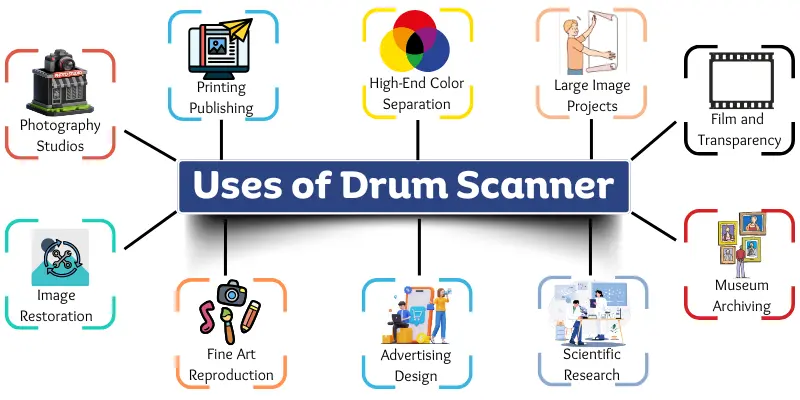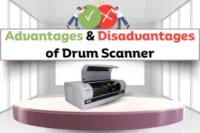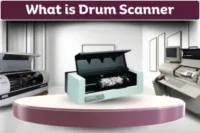Uses of Drum Scanner – Beginner’s Guide
Published: 8 Oct 2025
Have you ever wondered how magazines and artworks get perfect pictures? The answer is a drum scanner. This amazing type of scanner helps create sharp and colorful images. In this post, we will explain the top uses of drum scanner. You will see why it is important for printing, photography, and creative work.

Top 10 Uses of Drum Scanner
Drum scanners are powerful tools. They give very clear and sharp images. Many professionals use them in different fields.
Here are the top 10 uses of a drum scanner:
- Printing and Publishing
- Photography Studios
- Image Restoration
- Advertising Design
- Museum Archiving
- Scientific Research
- Film and Transparency Scanning
- Large Image Projects
- Fine Art Reproduction
- High-End Color Separation
Let’s understand above-mentioned drum scanner uses in simple way.
Printing and Publishing
Drum scanners help create very sharp images for print. They scan photos, illustrations, and graphics with high detail. Many magazines, books, and newspapers use them. They keep colors true and images clear. Publishers rely on drum scanners for top-quality results.
Photography Studios
Photography studios use drum scanners to capture detailed images from negatives and slides. They keep every color and detail accurate. Photographers scan their work to make high-quality prints for clients. It is perfect for portraits, landscapes, and creative projects.
Image Restoration
Drum scanners help restore old or damaged photos. They capture every small detail clearly. Professionals use them to fix colors, scratches, and fading. The scanned images can be edited on a computer easily. This way, old memories and historic photos look new again.
Advertising Design
Drum scanners help designers create clear images for ads and posters. They keep colors bright and details sharp. Marketing teams use them to prepare banners, flyers, and digital campaigns.
Museum Archiving
Museums use drum scanners to preserve valuable artworks and documents. They scan paintings, manuscripts, and historic items in high detail. This creates digital copies that last forever. Archivists can study and share these images safely.
Scientific Research
Scientists use drum scanners to capture detailed images for research. They scan slides, samples, and charts with high clarity. The scans help in studying small structures and colors accurately. Researchers can analyze and share the images easily.
Film and Transparency Scanning
Drum scanners can scan film and transparent slides clearly. They capture every color and tiny detail perfectly. Photographers and studios use them to convert old film into digital images. Drum scanners make film scanning fast and high-quality.
Large Image Projects
Drum scanners can handle very big images with ease. They scan posters, maps, and large artwork in high detail. Professionals scan images in parts and join them digitally. Drum scanners are perfect for projects that need large, high-quality prints.
Fine Art Reproduction
Drum scanners help create digital copies of paintings and artworks. They capture every color and texture clearly. Artists and museums use them to reproduce art accurately.
High-End Color Separation
Drum scanners help separate colors for professional printing. They scan images with exact color details. Printers use this to prepare high-quality brochures, magazines, and posters. Each color is clear and precise in the final print.
Conclusion
So, guys, let’s conclude. We learned how professionals use drum scanners for printing, photography, and art. The uses of drum scanner make it a powerful tool. Want to understand it better? Read our guide on what is drum scanner. Start exploring and see how it can help your work today. Don’t forget to comment your experience!
FAQs about Uses of Drum Scanner
Many beginners wonder how and why they are used. Here are the most common questions beginners ask about drum scanner uses.
Drum scanners capture very detailed and clear images. They are used for printing, photography, art reproduction, and research. They also help in restoring old photos. Professionals rely on them for projects that need high-quality images.
Even today, drum scanners give better detail and color than many other scanners. They keep images sharp and accurate. Professionals use them for prints, artwork, and scientific work. This makes their work look more professional.
Yes, drum scanners can scan film, slides, and negatives. They capture all colors and details perfectly. Photographers use them to convert old film into digital images. This keeps the images ready for editing or printing.
Yes, for high-quality images, drum scanners are better. They capture more detail and color accurately. Flatbed scanners are simpler but less precise. Drum scanners are ideal for professional and large projects.
Printing, photography, advertising, museums, and scientific research use drum scanners. They help produce sharp images for books, art, ads, and studies. Any field that needs high-quality images benefits from drum scanners.
Yes, drum scanners give very high resolution images. They can capture tiny details and accurate colors. This makes them perfect for prints, fine art, and large image projects.
Drum scanners are not as simple as flatbed scanners. Professionals need some training. Once you know the steps, scanning becomes easy. They provide excellent results every time.
Yes, if you need top-quality images, it is worth it. They are perfect for art, photography, and printing work. For casual scanning, simpler scanners are enough. Professionals still prefer drum scanners for precise results.

- Be Respectful
- Stay Relevant
- Stay Positive
- True Feedback
- Encourage Discussion
- Avoid Spamming
- No Fake News
- Don't Copy-Paste
- No Personal Attacks

- Be Respectful
- Stay Relevant
- Stay Positive
- True Feedback
- Encourage Discussion
- Avoid Spamming
- No Fake News
- Don't Copy-Paste
- No Personal Attacks



